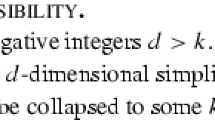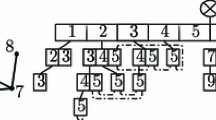Abstract
We prove that it is NP-complete to decide whether a given (3-dimensional) simplicial complex is collapsible. This work extends a result of Malgouyres and Francés showing that it is NP-complete to decide whether a given simplicial complex collapses to a 1-complex.













Similar content being viewed by others
Notes
That is, a formula in conjunctive normal form.
It can be shown that the resulting complex does not topologically embed into \(\mathbb {R}^3\) since it contains a Möbius band and an annulus glued to the central cycle of the band along one of the boundary components of the annulus. (The annulus is one third of the base floor and the band is formed by parts of the outer walls of the three rooms.) However, this non-embeddability fact is far beyond the needs of this paper.
For simplicity of notation, we keep the same numbers of vertices either for upper thick wall of \(X(\ell )\) or of \(X(\bar{\ell })\). However, we once more emphasize that that these two walls share the edge 89 only.
References
Attali, D., Lieutier, A.: Geometry-driven collapses for converting a Čech complex into a triangulation of a nicely triangulable shape. Discrete Comput. Geom. 1–28 (2015)
Benedetti, B.: Discrete Morse theory for manifolds with boundary. Trans. Am. Math. Soc. 364(12), 6631–6670 (2012)
Benedetti, B., Lutz, F.H.: Random discrete Morse theory and a new library of triangulations. Exp. Math. 23(1), 66–94 (2014)
Eğecioğlu, Ö., Gonzalez, T.F.: A computationally intractable problem on simplicial complexes. Comput. Geom. 6(2), 85–98 (1996)
Forman, R.: Morse theory for cell complexes. Adv. Math. 134(1), 90–145 (1998)
Haken, W.: Connections between topological and group theoretical decision problems. In: Word problems: decision problems and the Burnside problem in group theory (Conference dedicated to Hanna Neumann, University of California, Irvine, CA, 1969). Studies in Logic and the Foundations of Mathematics, vol. 71, pp. 427–441. North-Holland, Amsterdam (1973)
Hatcher, A.: Algebraic Topology. Cambridge University Press, Cambridge (2001)
Hog-Angeloni, C., Metzler, W., Sieradski, A.J.: Two-Dimensional Homotopy and Combinatorial Group Theory, vol. 197. Cambridge University Press, Cambridge (1993)
Joswig, M., Pfetsch, M.E.: Computing optimal Morse matchings. SIAM J. Discrete Math. 20(1), 11–25 (2006)
Malgouyres, R., Francés, A.R.: Determining whether a simplicial 3-complex collapses to a 1-complex is NP-complete. In: Coeurjolly, D. (ed.) Discrete Geometry for Computer Imagery (DGCI), pp. 177–188. Springer-Verlag, Berlin (2008)
Matoušek, J.: Using the Borsuk–Ulam theorem. Universitext, Springer-Verlag, Berlin (2003)
Munkres, J.R.: Elements of Algebraic Topology. Addison-Wesley, Reading, MA (1984)
Nabutovsky, A.: Einstein structures: existence versus uniqueness. Geom. Funct. Anal. 5(1), 76–91 (1995)
Tancer, M.: \(d\)-Collapsibility is NP-complete for \(d\) greater or equal to 4. Chic. J. Theor. Comput. Sci. 2010(3), 1–28 (2010)
Tancer, M.: Recognition of collapsible complexes is NP-complete. http://arxiv.org/abs/1211.6254v1 (2012)
Volodin, I.A., Kuznetsov, V.E., Fomenko, A.T.: The problem of discriminating algorithmically the standard three-dimensional sphere. Usp. Mat. Nauk 29(5), 71–168 (1974) (in Russian). English translation: Russ. Math. Surv. 29(5), 71–172 (1974)
Wegner, G.: \(d\)-Collapsing and nerves of families of convex sets. Arch. Math. 26, 317–321 (1975)
Acknowledgments
I would like to thank Dominique Attali, Bruno Benedetti, Anders Björner, Alexander Engström, André Lieutier and Rémy Malgouyres for helpful answers to my questions and/or providing useful references. I also thank the anonymous referee for a list of very helpful comments. Supported by the Göran Gustafsson postdoctoral fellowship. Partially supported by the project CE-ITI (GA ČR P202/12/G061) of the Czech Science Foundation.
Author information
Authors and Affiliations
Corresponding author
Additional information
Editor in Charge: Herbert Edelsbrunner
Appendix: Unrecognizability of Contractible Complexes
Appendix: Unrecognizability of Contractible Complexes
Here we briefly discuss the current state of art regarding the recognition of contractible complexes. We first focus on the case of complexes of dimension at least 5.
Theorem 11
(Novikov) For every \(d \ge 5\), it is algorithmically undecidable whether a given simplicial complex of dimension at most d is contractible.
The proof of Theorem 11 easily follows from [16, §10]. We sketch a proof here.
Sketch of a proof of Theorem 11
Novikov [16, §10] shows the existence of efficiently constructible sequence \(M_j\) of d-manifolds such that \(M_j\) is a ball if and only if \(\pi (M_j)\) is trivial and it is algorithmically undecidable whether \(\pi (M_j)\) is trivial. In particular, \(M_j\) is contractible if and only if \(\pi (M_j)\) is trivial. In order to finish the proof, we need to know that \(M_j\) can be efficiently constructed as a simplicial complex. This can be indeed done by inspecting the proof in [16] with not too much effort. \(\square \)
An alternative proof can be obtained from a more complete exposition by Nabutovsky; see the appendix of [13]. This is done in an earlier version of this paper [15]. The proof there is in full detail. It is easier to get a triangulation, because the analogues of \(M_j\) are zero sets of some polynomials with rational coefficients. On the other hand, the overall proof is slightly more complicated since it is necessary to transform spheres into balls.
The dimension 5 in Theorem 11 can be dropped to 4, if we greedily collapse 5-dimensional simplices of \(\Theta _i\) via some of their 4-dimensional faces. Note that we cannot get stuck on a 5-dimensional complex, since \(\Theta _i\) is connected. (The author learnt this idea, in a different context, from Bruno Benedetti.)
On the other hand, the contractibility question for complexes of dimension at most 1 is trivially polynomial-time solvable since it is equivalent with recognition of trees (as graphs).
Regarding complexes of dimension at most 2 or 3, the decidability of the contractibility question is open in these two cases to the best knowledge of the author. In particular, in dimension 2, this question is equivalent to the triviality of finite balanced representations of groups; see the exercise above in [8, Sect I.1.4].
We also remark that it is well-known that the triviality of the fundamental group is algorithmically undecidable already for complexes of dimension 2; see, e.g., [6]. This is equivalent with contractibility of each loop in the complex. However, this question should not be confused with the contractibility of the complex. On the level of group presentations, the triviality of the fundamental group corresponds to the triviality of any finite presentations of groups, not necessarily balanced.
Rights and permissions
About this article
Cite this article
Tancer, M. Recognition of Collapsible Complexes is NP-Complete. Discrete Comput Geom 55, 21–38 (2016). https://doi.org/10.1007/s00454-015-9747-1
Received:
Accepted:
Published:
Issue Date:
DOI: https://doi.org/10.1007/s00454-015-9747-1




